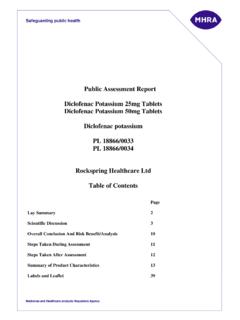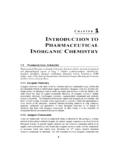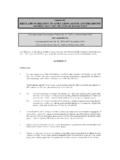Transcription of AUGMENTIN DUO and AUGMENTIN DUO FORTE TABLETS …
1 AUGMENTIN DUO and AUGMENTIN DUO FORTE TABLETS PRODUCT INFORMATION (Amoxycillin Trihydrate and potassium Clavulanate) Issue 8 (Marketed) DESCRIPTION AUGMENTIN DUO and AUGMENTIN DUO FORTE TABLETS ( AUGMENTIN TABLETS ) are combination products containing the semisynthetic antibiotic, amoxycillin (as the trihydrate) and the -lactamase inhibitor, potassium clavulanate (as the potassium salt of clavulanic acid). Chemically, amoxycillin is D-(-)- -amino-p-hydroxybenzylpenicillin. It is susceptible to hydrolysis by -lactamases. Amoxycillin trihydrate may be represented structurally as: CAS 61336-70-7.
2 Clavulanic acid is produced by the fermentation of Streptomyces clavuligerus. It is an irreversible inhibitor of many -lactamase enzymes except type 1 (Richmond). It is a -lactam compound with only weak antibacterial activity. Chemically potassium clavulanate is potassium Z-(2R,5R)-3-( -hydroxyethylidene) clavam-2-carboxylate, and may be represented structurally as: CAS 61177-45-5. AUGMENTIN DUO FORTE TABLETS also contain the inactive ingredients: magnesium stearate, sodium starch glycollate, silica - colloidal anhydrous and microcrystalline cellulose. The tablet coating contains titanium dioxide, hypromellose 5 & 15 cps, Macrogol 4000 & Macrogol 6000.
3 AUGMENTIN DUO TABLETS also contain the inactive ingredients: magnesium stearate, sodium starch glycollate, silica - colloidal anhydrous and microcrystalline cellulose. The tablet coating contains titanium dioxide, hypromellose 15cps, propylene glycol, ethylcellulose and dimethicone 200. AUGMENTIN DUO and AUGMENTIN DUO FORTE TABLETS PRODUCT INFORMATION 2 (16) Issue 8 (Marketed) PHARMACOLOGY Pharmacokinetics Absorption AUGMENTIN TABLETS are stable in the presence of gastric acid.
4 Their two components are rapidly absorbed if administered before or with a meal, but if given after meals, the serum levels of clavulanic acid are significantly reduced. To optimise absorption of clavulanic acid AUGMENTIN TABLETS should be administered at the start of a meal. The pharmacokinetics of amoxycillin are not affected by food. Oral administration of AUGMENTIN DUO FORTE (875mg/125mg) TABLETS every 12 hours was compared with AUGMENTIN FORTE (500mg/125mg) every 8 hours at the start of a light meal. The following mean pharmacokinetic parameters were observed for amoxycillin for AUGMENTIN DUO FORTE (875/125mg) taken every 12 hours and AUGMENTIN FORTE (500mg/125mg) taken every 8 hours respectively.
5 Peak plasma concentration (Cmax) of and g/mL, area under the plasma concentration-time curve between 0 and 24 hours after the first dose (AUC(0-24 hours)) of and , half life (t ) of and hours, time to peak plasma concentration (Tmax) of and hours and the time above the minimum inhibitory concentration (TMIC 24 hours) of hours and hours. The following pharmacokinetic parameters were observed for clavulanic acid for AUGMENTIN DUO FORTE (875/125mg) TABLETS taken every 12 hours and AUGMENTIN FORTE (500mg/125mg) taken every 8 hours respectively: Cmax of and g /mL, AUC(0-24 hours) of and , t of and hours and Tmax of and hours, and (TMIC 24 hours) of hours and hours.
6 The t and Cmax for clavulanate for AUGMENTIN DUO FORTE were not significantly different from AUGMENTIN FORTE . However, the AUC(0-24 hours) was reduced, as would be expected with the lower daily dose of clavulanate ie 250mg in AUGMENTIN DUO FORTE vs 375mg in AUGMENTIN FORTE Oral administration of AUGMENTIN DUO (500mg/125mg) every 12 hours was compared with AUGMENTIN (250mg/125mg) every 8 hours at the start of a light meal. The following mean pharmacokinetic parameters were observed for amoxycillin for AUGMENTIN DUO (500/125mg) taken every 12 hours and AUGMENTIN (250mg/125mg) taken every 8 hours respectively.
7 Peak plasma concentration (Cmax) of and g/mL, area under the plasma concentration-time curve between 0 and 24 hours after the first dose (AUC(0-24 hours)) of and , half life (t ) of and hours, time to peak plasma concentration (Tmax) AUGMENTIN DUO and AUGMENTIN DUO FORTE TABLETS PRODUCT INFORMATION 3 (16) Issue 8 (Marketed) of and hours and the time above the minimum inhibitory concentration (TMIC 24 hours) of hours and hours. The following pharmacokinetic parameters were observed for clavulanic acid for AUGMENTIN DUO (500/125mg) taken every TABLETS every 12 hours and AUGMENTIN (250mg/125mg) taken every 8 hours respectively: Cmax of and g/mL, AUC(0-24 hours) of and , t of and hours and Tmax of and hours, and (TMIC 24 hours) of hours and hours.
8 Distribution Following oral administration, both amoxycillin and clavulanic acid have been shown to diffuse in significant concentrations into pus, bile, and pleural, synovial and peritoneal fluids. Both penetrate poorly into the CSF when the meninges are normal. Amoxycillin penetrates into the CSF better through inflamed meninges, but the maximum concentrations are still much lower than the peak serum levels. There are no data at present on the CSF penetration of clavulanic acid in patients with meningeal inflammation. Neither amoxycillin nor clavulanic acid is highly protein bound.
9 Clavulanic acid has been variously reported to be bound to human serum in the range of 9 - 30% and amoxycillin approximately 20% bound. From animal studies, there is no evidence to suggest either component accumulates in any organ. Elimination As with other penicillins, renal excretion is the major route of amoxycillin clearance, while clavulanate elimination is via both renal and non-renal mechanisms. Approximately 70% of the dose of amoxycillin is excreted in urine as amoxycillin. For clavulanic acid, following the administration of 125mg of radiolabelled potassium clavulanate orally to normal volunteers 68% of the administered radioactivity was recovered in the urine in 24 hours.
10 Of this 34% (ie. 23% of the administered dose) represented unchanged clavulanic acid. 2,5-dihydro-4-(2-hydroxyethyl)-5-oxo-1H- pyrrole-3-carboxylic acid (the major metabolite) and 1-amino-4-hydroxy-butan-2-one accounted for a further 23% and 12% (ie. 16% and 8% respectively of the administered dose). Small amounts of other yet unidentified metabolites were also present. These metabolites were also present in the urine of rat and dog. The extent of urinary excretion of clavulanic acid and its metabolites is lower in rat urine than in dog and human urine. Concurrent administration of probenecid delays amoxycillin excretion but does not delay renal excretion of clavulanic acid.






